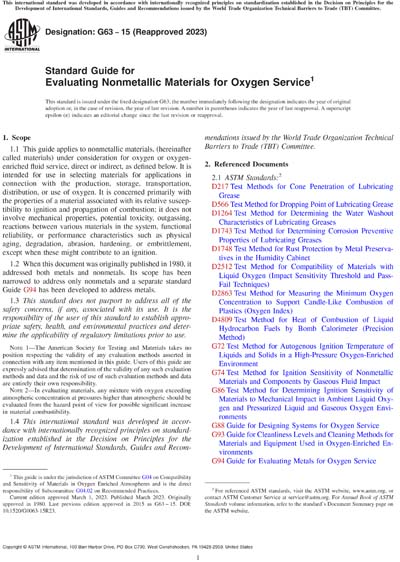Most recent
ASTM G63-15(2023)
Standard Guide for Evaluating Nonmetallic Materials for Oxygen Service
1.1This guide applies to nonmetallic materials, (hereinafter called materials) under consideration for oxygen or oxygen-enriched fluid service, direct or indirect, as defined below. It is intended for use in selecting materials for applications in connection with the production, storage, transportation, distribution, or use of oxygen. It is concerned primarily with the properties of a material associated with its relative susceptibility to ignition and propagation of combustion; it does not involve mechanical properties, potential toxicity, outgassing, reactions between various materials in the system, functional reliability, or performance characteristics such as physical aging, degradation, abrasion, hardening, or embrittlement, except when these might contribute to an ignition.
1.2When this document was originally published in 1980, it addressed both metals and nonmetals. Its scope has been narrowed to address only nonmetals and a separate standard Guide G94 has been developed to address metals.
1.3This standard does not purport to address all of the safety concerns, if any, associated with its use. It is the responsibility of the user of this standard to establish appropriate safety, health, and environmental practices and determine the applicability of regulatory limitations prior to use.
Note 1:The American Society for Testing and Materials takes no position respecting the validity of any evaluation methods asserted in connection with any item mentioned in this guide. Users of this guide are expressly advised that determination of the validity of any such evaluation methods and data and the risk of use of such evaluation methods and data are entirely their own responsibility.
Note 2:In evaluating materials, any mixture with oxygen exceeding atmospheric concentration at pressures higher than atmospheric should be evaluated from the hazard point of view for possible significant increase in material combustibility.
1.4This international standard was developed in accordance with internationally recognized principles on standardization established in the Decision on Principles for the Development of International Standards, Guides and Recommendations issued by the World Trade Organization Technical Barriers to Trade (TBT) Committee.
ASTM International [astm]

